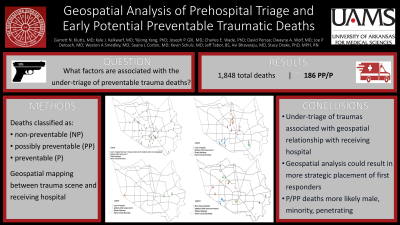Back

Trauma
Category: Quickshot Oral Session 23
Quickshot Oral : Quickshot Oral Session 23
PREHOSPITAL TRIAGE AND EARLY POTENTIALLY PREVENTABLE TRAUMA DEATHS
Tuesday, February 14, 2023
7:00am – 8:00am East Coast USA Time


Garrett N. Klutts, MD
Resident, General Surgery
UAMS, United States
Garrett N. Klutts, MD
Resident, General Surgery
UAMS, United States
Presenter(s)
Principal Contact(s)
Objectives: Severely injured patients often depend upon prompt prehospital triage for their survival. This study aimed to examine the under- or over-triage of preventable or potentially preventable traumatic deaths, as well as the factors associated with these early trauma deaths.
Methods: A retrospective review of Harris County, TX death-related record revealed 1848 deaths within 24 hours of injury in a single year. A multi-disciplinary panel of trauma experts established a consensus of the deaths as preventable (P), potentially preventable (PP), or non-preventable (NP). Regional and American College of Surgeons (ACS) triage guidelines were used to evaluate the under/over triage rates. The analysis evaluated the geospatial relationship between each death and the receiving hospital.
Results: There were 186 P/PP deaths out of the 1848 total deaths (10.1%), of which 89 (47.8%) died in the prehospital setting. The remaining 97 (52.2%) patients were transported to an acute care hospital and were pronounced in the ED/OR within 24 hours. Of these 97 patients, 35 (36%) were transported to level III, IV, or non-trauma hospitals. Geospatial analysis revealed an association between the location of initial injury and proximity to receiving level III, level IV, and non-trauma centers.
Conclusion: Geospatial analysis supports proximity to the nearest hospital as one of the primary reasons for under-triage. Stricter adherence to regional trauma triage guidelines may improve the number of patients transported to a higher level of care, and decrease the number of preventable trauma deaths.
Methods: A retrospective review of Harris County, TX death-related record revealed 1848 deaths within 24 hours of injury in a single year. A multi-disciplinary panel of trauma experts established a consensus of the deaths as preventable (P), potentially preventable (PP), or non-preventable (NP). Regional and American College of Surgeons (ACS) triage guidelines were used to evaluate the under/over triage rates. The analysis evaluated the geospatial relationship between each death and the receiving hospital.
Results: There were 186 P/PP deaths out of the 1848 total deaths (10.1%), of which 89 (47.8%) died in the prehospital setting. The remaining 97 (52.2%) patients were transported to an acute care hospital and were pronounced in the ED/OR within 24 hours. Of these 97 patients, 35 (36%) were transported to level III, IV, or non-trauma hospitals. Geospatial analysis revealed an association between the location of initial injury and proximity to receiving level III, level IV, and non-trauma centers.
Conclusion: Geospatial analysis supports proximity to the nearest hospital as one of the primary reasons for under-triage. Stricter adherence to regional trauma triage guidelines may improve the number of patients transported to a higher level of care, and decrease the number of preventable trauma deaths.

